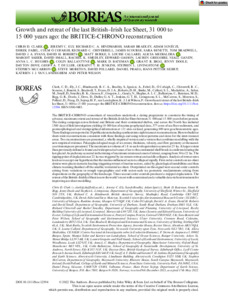CLARK, Chris D, ELY, Jeremy C, HINDMARSH, Richard CA, BRADLEY, Sarah, IGNÉCZI, Adam, FABEL, Derek, Ó COFAIGH, Colm, CHIVERRELL, Richard C, SCOURSE, James, BENETTI, Sara, BRADWELL, Tom, EVANS, David JA, ROBERTS, David H, BURKE, Matt, CALLARD, S Louise, MEDIALDEA, Alicia, SAHER, Margot, SMALL, David, SMEDLEY, Rachel K, GASSON, Edward, GREGOIRE, Lauren, GANDY, Niall, HUGHES, Anna LC, BALLANTYNE, Colin, BATEMAN, Mark D, BIGG, Grant R, DOOLE, Jenny, DOVE, Dayton, DULLER, Geoff AT, JENKINS, Geraint TH, LIVINGSTONE, Stephen L, MCCARRON, Stephen, MORETON, Steve, POLLARD, David, PRAEG, Daniel, SEJRUP, Hans Petter, VAN LANDEGHEM, Katrien JJ and WILSON, Peter
(2022).
Growth and retreat of the last British–Irish Ice Sheet, 31 000 to 15 000 years ago: the BRITICE‐CHRONO reconstruction.
Boreas.
[Article]
Documents
30706:608040
![[thumbnail of clark2022boreas.pdf]](https://shura.shu.ac.uk/30706/1.hassmallThumbnailVersion/clark2022boreas.pdf)

Preview
Abstract
The BRITICE-CHRONO consortium of researchers undertook a dating programme to constrain the timing of advance, maximum extent and retreat of the British–Irish Ice Sheet between 31 000 and 15 000 years before present. The dating campaign across Ireland and Britain and their continental shelves, and across the North Sea included 1500 days of field investigation yielding 18 000 km of marine geophysical data, 377 cores of sea floor sediments, and geomorphological and stratigraphical information at 121 sites on land; generating 690 new geochronometric ages. These findings are reported in 28 publications including synthesis into eight transect reconstructions. Here we build ice sheet-wide reconstructions consistent with these findings and using retreat patterns and dates for the inter-transect areas. Two reconstructions are presented, a wholly empirical version and a version that combines modelling with the new empirical evidence. Palaeoglaciological maps of ice extent, thickness, velocity, and flow geometry at thousand-year timesteps are presented. The maximum ice volume of 1.8 m sea level equivalent occurred at 23 ka. A larger extent than previously defined is found and widespread advance of ice to the continental shelf break is confirmed during the last glacial. Asynchrony occurred in the timing of maximum extent and onset of retreat, ranging from 30 to 22 ka. The tipping point of deglaciation at 22 ka was triggered by ice stream retreat and saddle collapses. Analysis of retreat rates leads us to accept our hypothesis that the marine-influenced sectors collapsed rapidly. First order controls on ice-sheet demise were glacio-isostatic loading triggering retreat of marine sectors, aided by glaciological instabilities and then climate warming finished off the smaller, terrestrial ice sheet. Overprinted on this signal were second order controls arising from variations in trough topographies and with sector-scale ice geometric readjustments arising from dispositions in the geography of the landscape. These second order controls produced a stepped deglaciation. The retreat of the British–Irish Ice Sheet is now the world’s most well-constrained and a valuable data-rich environment for improving ice-sheet modelling.
Actions (login required)
 |
View Item |



 Tools
Tools Tools
Tools